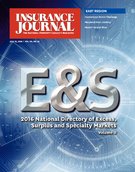We have all seen the stories in the news. After many years of a declining trend in the number of accidents, the number of accidents has spiked in the last two years. Insurers have an opportunity to educate the public and policymakers on the effects of the increase on insurance costs, and work together to find solutions.
The National Highway Traffic Safety Administration reports that motor-vehicle deaths nationally rose nearly 8 percent from 2014 to 2015 — the largest annual increase in 50 years. At a time when enhanced technology has made cars safer, several factors are now combining to make our roads more dangerous. Driver behavior is the primary cause of most auto accidents. Distracted drivers are one of the biggest hazards on the roads today.
Nationally, nearly 3,200 people were killed and an estimated 431,000 injured in crashes involving distracted drivers in 2014, according to the NHTSA. Whether it’s making a quick call, firing off a text, juggling a donut and coffee, fiddling with the navigation system, or turning our attention to kids and pets in the back seat — in that short lapse of focus, all too often we can cause, or fail to avoid, a crash.
Distracted walking is becoming its own epidemic, and pedestrians glued to their smartphones are putting themselves and motorists in danger. The University of Buffalo says distracted walking may result in more accidents per mile than distracted driving. That assertion is astonishing considering one-in-four car crashes involves a phone and, in 2014, more than 10 percent of all fatal car crashes was the result of cellphone use.
And it’s not just driving distracted. Drivers are impaired too — law enforcement increasingly finds drivers impaired by prescription medication, marijuana and other drugs.
For example, from 2007 to 2014, the number of nighttime weekend drivers in the U.S. with marijuana in their systems increased by nearly 50 percent, according to the NHTSA.
All of these factors can be cited as reasons why traffic accidents, fatalities and other injuries are increasing — and why we’re starting to see the byproduct of those trends: rising insurance costs.
It’s hard to tell any customer that costs are going up, but insurance policyholders need to understand the reality of what’s happening. Consumers need to be aware of the rise in these accident trends and we need to work together to make our roads safer by educating the public about the importance of staying focused.
The industry also can play a role in educating consumers on solutions to make our roads safer and keep rates in check.
Simple modifications to driver behavior can have a big impact, and reminders to slow down, pay attention, put down the smartphone, resist the urge to tailgate and drive sober can help. One excellent way to support the public education effort is to create or join an existing group focused on distracted driving.
Public policy also plays a role, and we need to advocate for the implementation and enforcement of distracted and aggressive driving laws. Impaired driving laws also need to be evaluated, and the effect of legalizing marijuana on driving safety needs to be examined.
Insurance professionals can also call attention to these and other issues by generating media attention with letters-to-the-editors. The Property Casualty Insurers Association of America and other industry groups are working to educate consumers and policymakers on these issues.
We are all in this together. Raising awareness about these alarming statistics and the continued threat of distracted driving can help make our roads safer and keep costs down for our customers.
Topics Carriers Personal Auto
Was this article valuable?
Here are more articles you may enjoy.



 Cracks in O’Hare Columns Aren’t Insured Property Damage, Just Bad Product – Court
Cracks in O’Hare Columns Aren’t Insured Property Damage, Just Bad Product – Court  Three Insurers Reject Chevron’s $57 Million Claim for Iran Oil Seizure
Three Insurers Reject Chevron’s $57 Million Claim for Iran Oil Seizure  Pfizer Agrees to Settle More Than 10,000 Zantac Cancer Lawsuits
Pfizer Agrees to Settle More Than 10,000 Zantac Cancer Lawsuits  Fannie and Freddie Hit Pause on Replacement-Value Requirements for Home Insurance
Fannie and Freddie Hit Pause on Replacement-Value Requirements for Home Insurance 


